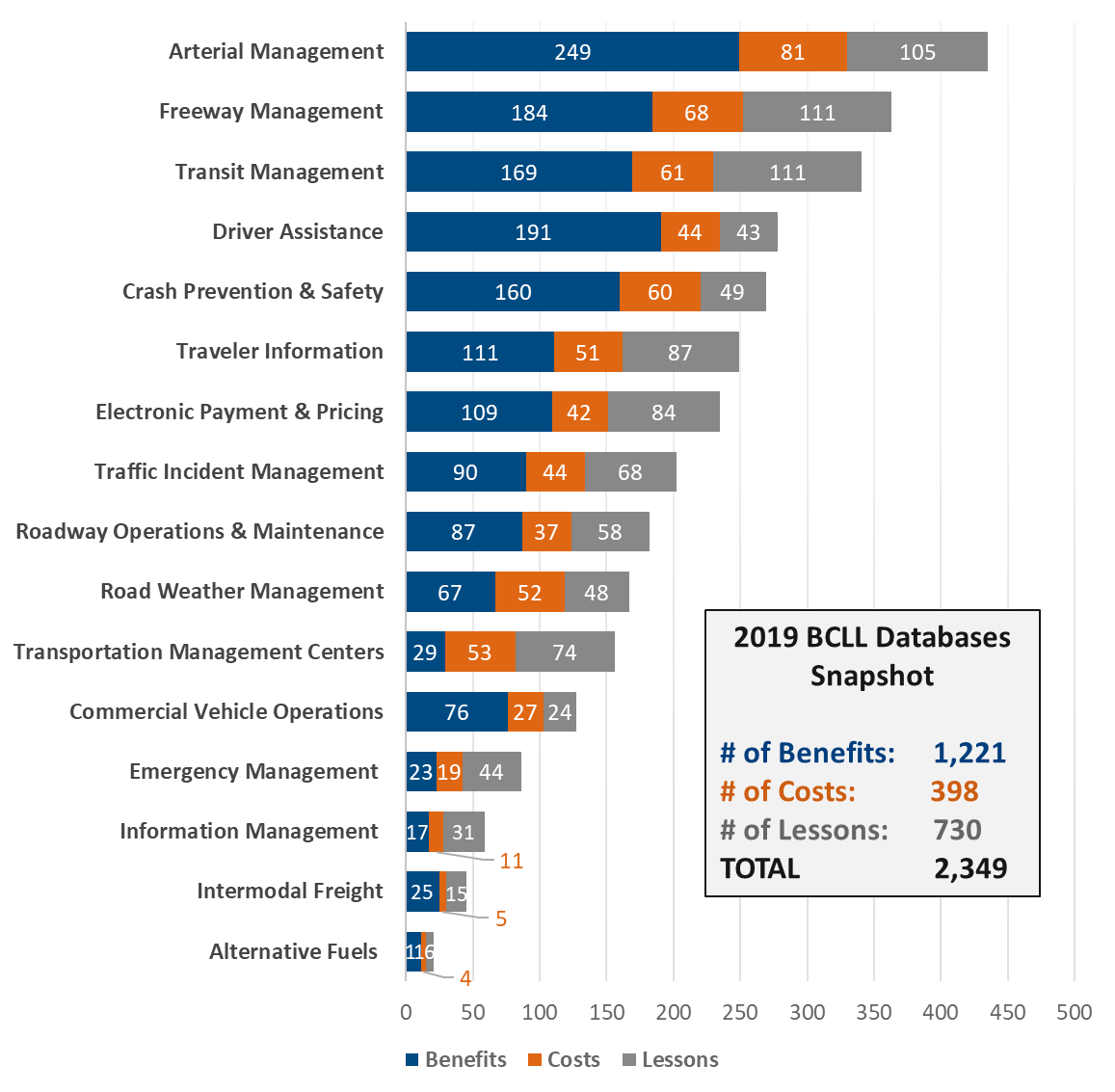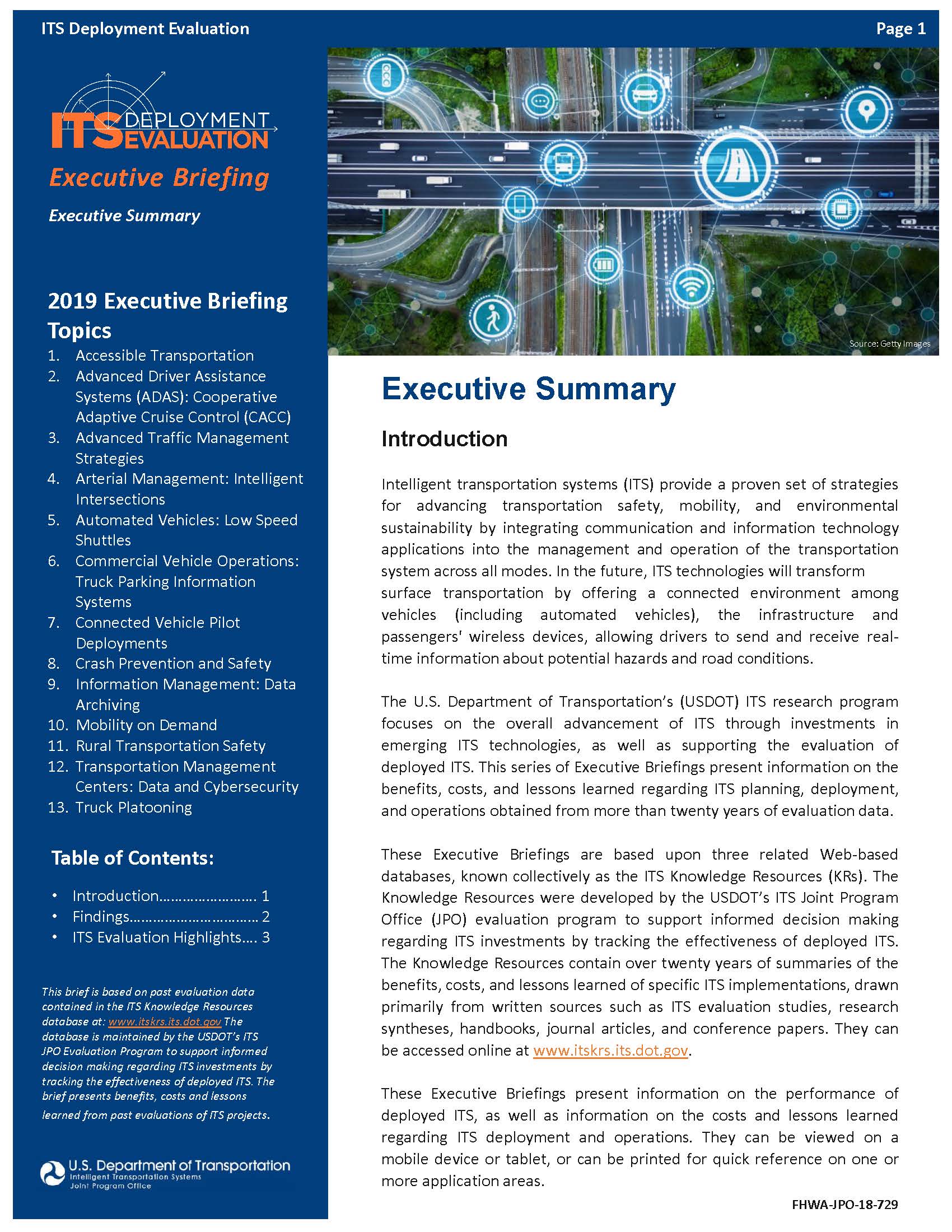Executive Summary (2019)
2019 Executive Briefing
Introduction
Intelligent transportation systems (ITS) provide a proven set of strategies for advancing transportation safety, mobility, and environmental sustainability by integrating communication and information technology applications into the management and operation of the transportation system across all modes. In the future, ITS technologies will transform surface transportation by offering a connected environment among vehicles (including automated vehicles), the infrastructure and passengers' wireless devices, allowing drivers to send and receive real-time information about potential hazards and road conditions.
These Executive Briefings are based upon three related Web-based databases, known collectively as the ITS Knowledge Resources (KRs). The Knowledge Resources were developed by the USDOT’s ITS Joint Program Office (JPO) evaluation program to support informed decision making regarding ITS investments by tracking the effectiveness of deployed ITS. The Knowledge Resources contain over twenty years of summaries of the benefits, costs, and lessons learned of specific ITS implementations, drawn primarily from written sources such as ITS evaluation studies, research syntheses, handbooks, journal articles, and conference papers. They can be accessed online at www.itskrs.its.dot.gov.
These Executive Briefings present information on the performance of deployed ITS, as well as information on the costs and lessons learned regarding ITS deployment and operations. They can be viewed on a mobile device or tablet, or can be printed for quick reference on one or more application areas.
Findings
As of April 1, 2019, there were a total of 2,349 entries of ITS benefits, costs, and lessons learned in the ITS Knowledge Resources databases from the United States and around the world. Of the 2,349 entries, 208 entries have been added since the publication of the 2018 BCLL Update report. The figure below gives an overview of the summaries in the ITS Knowledge Resources database by Application Area.
2019 Executive Briefing Highlights
In the 20+ years that the ITS JPO has been tracking the evaluation of ITS technologies, there has been steady growth in the number of studies documenting the benefits, costs and lessons learned of ITS. Every few years, the ITS Evaluation program reflects on recent entries to the ITS Knowledge Resources to assess changing topics and trends.
For 2019, thirteen Executive Briefings have been prepared that feature the most popular Application Areas from Figure 1 as well as emerging research areas in connected and automated vehicle technology and mobility services. The evaluation highlights from the 2019 Executive Briefings are detailed below.
Accessible Transportation
- Transportation is critical to enhancing access to education, jobs, healthcare, and independent living within communities.
- AbleLink Wayfinding and navigation Field Test Case Study showed excellent results helping people with cognitive disabilities travel independently.
Advanced Driver Assistance Systems (ADAS): Cooperative Adaptive Cruise Control (CACC)
- Advanced driver assistance systems may reduce congestion, reduce emissions, and improve safety.
- Adaptive cruise control technology can add between $300 to $10,800 to the price of a new vehicle, with a median cost of $4,500. However, as technology progresses, the cost of ACC will continue to decrease.
- The understanding of different adaptive and cooperative adaptive cruise control technologies is increasing and data are available for anyone to study.
Advanced Traffic Management Strategies
- A variety of Active Traffic Management strategies are available to manage congestion and increase safety and throughput on the transportation network.
- ATM strategies have been shown to effectively reduce speed limits in work zones, making a safer environment for construction workers by limiting the impacts of congestion and improving travel time and reducing crash rates.
Arterial Management: Intelligent Intersections
- Simulation models indicate intelligent intersections can reduce rear-end conflicts by 46 to 54 percent with only 10 percent connected vehicle market penetration.
- Intersection Signal Phase and Timing (SPaT) data shared with connected vehicles equipped with adaptive cruise control features can smooth speed profiles and reduce fuel consumption up to 40 percent.
Automated Vehicles: Low Speed Shuttles
- Automated Low-speed shuttles (LSS) (Level 4 SAE Automation) hold up to 15 passengers, have a top speed of 25 miles per hour, and travel about 10 miles per hour.
- Potential benefits of LSS include solving first/last mile challenges, fuel savings, reducing the cost of paratransit, and reducing congestion from drivers looking for parking.
- Issues include public acceptance, the cost of employing an onboard operator, electric vehicle battery performance, and the lack of a clear business model.
Commercial Vehicle Operations: Truck Parking Information Systems
- Truck parking information systems have benefit-to-cost ratios ranging from 4.27 to 7.
- 67 percent of truck drivers surveyed reported that realtime parking information systems significantly improved their ability to find parking and comply with HOS regulations.
Connected Vehicle Pilot Deployments
- In June 2018, the three Connected Vehicle Pilots successfully demonstrated cross-site over-the-air interoperability among six participating vendors.
- Following an intensive two-year period spent designing and building the connected vehicle systems, the CV Pilot sites are now in the final stages of preparation for full-scale deployment of roadside infrastructure and equipping of vehicle fleets.
Crash Prevention and Safety
- The new wave of crash prevention and safety strategies includes the integration of vehicle and infrastructure safety systems and implementation of connected vehicle technologies for safety applications.
- During the EU’s VRUITS project, innovative ITS applications were demonstrated in the Netherlands and Spain to compile evidence-based recommended practices on how vulnerable road users can be integrated into innovative Intelligent Transport Systems (ITS).
Information Management: Data Archiving
- Archived data provides information about the traffic system not previously available and enables analyses of problems and solutions not possible with more static or less detailed traditional data.
- The ability to do before/after studies opens new possibilities as far as measuring, monitoring and evaluating the performance of systems and new infrastructure projects.
Mobility on Demand
- Travel and mobility demands are evolving from an emphasis on private automobile ownership to more flexible, public and private options which incorporate shared-use and multimodal integration.
- MOD deployments often face challenges in navigating complex business models. However, as more and more deployments are launched, successful solutions are beginning to stand out as instructive examples.
- Massachusetts Bay Transportation Authority (MBTA) pilot paratransit program, The RIDE, saved customers a total of 21,000 hours of trip time.
Rural Transportation Safety
- The fatality rate on rural roads is more than twice that of roads in urbanized areas. The different environmental and traffic characteristics in rural areas contribute to the challenges presented by these facilities.
- Artificial intelligence is being investigated in Iowa to determine if it can effectively predict road conditions, helping support decisions made by the Department of Transportation that impact safety.
- Dilemma zone protection systems evaluated in rural parts of Maryland are helping to reduce the number of angle crashes.
Transportation Management Centers: Data and Cybersecurity
- Coordinating and securing data through a TMC has the benefits of improving mobility, reducing environmental impacts, and increasing the overall safety of travelers.
- A TMC can make cyber-attacks harder by taking a “Defense in Depth” approach and interrupting as many of the attacker’s steps as possible.
Truck Platooning
- Connectivity between trucks equipped with automated vehicle technology allow them to operate more smoothly as a unit and automatically reduce and control following gaps between vehicles.
- A study funded by the Department of Energy, NREL, found that 55.7 percent of all classifiable miles driven were “platoonable”, presenting the opportunity for significant fuel and emissions savings.
All data referenced is available through the ITS Knowledge Resources Database, which can be found at http://www.itsknowledgeresources.its.dot.gov/.


